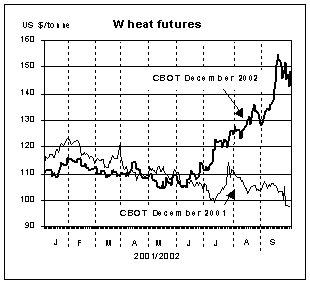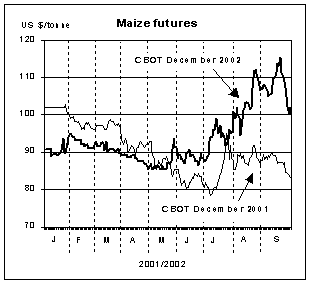Wheat prices continued to increase since the start of the season in July, as concerns grew about supplies in the United States, Canada and Australia, all key exporting countries. Repeated cuts in this year’s crop forecasts in the United States pushed up the export price of the medium to high quality milling wheat. In September, US wheat No. 2 HRW averaged US$189 per tonne, up US$62 per tonne, or nearly 50 percent, from the corresponding month last year. US soft wheat (No. 2 SRW) values also continued to react nervously to this year’s likely drop in US production and dwindling stocks, with prices climbing to US$156 per tonne, up 44 percent from the previous year. Similarly, prices in the US futures markets moved up persistently – by as much as 50 percent - over the past three months. In early September, wheat futures for December delivery at the Chicago Board of Trade (CBOT) soared to 5-year highs (the highest since May 1997) as buying over fears about shrinking supplies gathered momentum. The sharp rally in high milling quality wheat prices in recent months also reflect major crop losses in Canada and Australia, where the availability of wheat for exports are likely to be curbed significantly this season. Until the final impact of the severe drought and sharply lower yields could be determined in Canada, the Canadian Wheat Board decided in mid-September to withdraw from the export market. In Australia, this year’s drought-savaged wheat crop could reduce exports to the lowest volume since 1995/96.
| 2002 | 2001 | ||
| Sept. | June | Sept. | |
| (. . . . . . US$/tonne . . . . . .) | |||
| United States | |||
| Wheat | 189 | 133 | 127 |
| Maize | 115 | 92 | 90 |
| Sorghum | 120 | 95 | 98 |
| Argentina | |||
| Wheat | 153 | 150 | 119 |
| Maize | 108 | 92 | 88 |
| Thailand | |||
| Rice white | 191 | 210 | 176 |
| Rice, broken | 152 | 152 | 151 |
* Prices refer to the monthly average. For sources see Appendix Tables A.6 and A.7.

The soaring wheat prices in recent months come at the time when export supplies in a number of non-traditional exporting countries are large as a result of yet another good season. In particular, soft milling and feed wheat in the Russian Federation, Ukraine and India are regarded as more competitive than supplies from North America and Australia. Recently, prices in the Russian Federation and Ukraine also began to strengthen as the removal of import tariffs on lower quality wheat in the EU could provide a possible major destination for Black Sea wheat exports for the second season in a row.
The forecasts for tightening wheat supplies among the major exporting countries is likely to continue to provide support to prices for a few more months to come. However, with a sharp contraction in world import demand this season, large alternative wheat supplies and a possible increase in next year’s plantings (in response to current strong prices), wheat prices could begin to slide later in the season.
The maize market also witnessed a similar pattern since July with prices rising almost continuously as a result of supply concerns and the worsening of the crop conditions in the United States, the world’s largest consumer and exporter of maize. While earlier indications suggested higher production levels, the September report from the United States Department of Agriculture put the forecast for 2002 maize output at 17 million tonnes below the already reduced 2001 level. In September, US maize export price (US No.2 Yellow) averaged US$115 per tonne, up US$23 per tonne since June and US$25 per tonne, or 28 percent, above the corresponding month last year. The expected decline in the US maize crop provided the main stimulus for sharp price rises also in the futures market. The December 2002 maize futures at CBOT continued to rise, although during August and September, they were extremely volatile because of weather uncertainties. By late September, maize futures for December delivery were quoted at US$102 per tonne, still US$19 per tonne up from the corresponding period last year. In the coming months, the approach of the harvest in several major producing regions could start putting downward pressure on prices.

The sharp decline in production in the United States comes at a time when demand for maize is relatively strong. While another year of large exports from China is seen as a restraint to rising maize prices, exportable supplies from other origins are forecast at below previous season’s levels and the overall tightness, especially in the United States, is expected to keep prices well above these in the previous season.

International rice prices of different origins and grades have followed opposing trends over the past few months. Such movements have offset each other in the new FAO Export Total Price Index for Rice (1998-2000 =100), which remained at 73 points in July through to September. For instance, rice price quotations from Pakistan have fallen in anticipation of fresh arrivals of supplies into its market, while, in contrast, strong demand for United Sates rice, particularly to cover food aid programme commitments, have led to a firming of its price quotations. In Viet Nam, prices have remained steady for high quality rice, but they have risen slightly for broken rice.
In Thailand, the Government has begun selling rice from its reserves to exporters, to make room for new procurement purchases under its 2002/03 paddy intervention scheme. Much of these sales are reported to consist of high quality rice, which have contributed to recent falls in their export quotations. For instance, prices of the Thai 100% B dropped by an average US$12 from July to US$191 per tonne in September. On the other hand, prices of the counterpart United States long grain 2/4 percent climbed by US$12 over this period to US$215 per tonne. This was the first time since April this year, that US rice quotations were showing a premium over the Thai 100% B. The overall effect of diverging trends for high quality rice from different origins was minimal on the FAO’s High Quality Indica Price Index, which dropped only 1 point from July to 73 points.
Similarly, FAO’s Low Quality Indica Price Index has fallen by 1 point to 76 points between July and September, as prices for broken rice in major exporting countries have tended to converge towards India’s 25 percent quotations, which, at US$138 per tonne, remain very competitive. FAO’s Japonica Price Index has fluctuated in recent months, but overall, it has declined by 1 point since July, reflecting a US$23 per tonne dip in prices of the United States medium grain 2/4 percent in September. Finally, Basmati prices have staged a strong recovery, as reflected in FAO’s Aromatic Price Index, which rose from 78 points in July to 83 points in September. The increase was mainly on account of the change in India’s export specifications.
The price outlook for the short-term appears somewhat mixed. On the positive side, global import prospects have improved, since some major importing countries have lowered production prospects this season, which might induce larger purchases at a moment when market prices are still considered to be attractive. In addition, policy procurement from farmers in Thailand, which in recent months has translated into stronger export quotations will continue to support domestic prices. On the negative side, however, new supplies from northern hemisphere countries are expected to peak over the next few months, which will have a bearish effect on prices, especially since major exporters still hold large rice inventories.